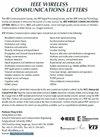SNR-EQ-JSCC:基于信噪比嵌入和查询的联合信源信道编码
IF 5.5
3区 计算机科学
Q1 COMPUTER SCIENCE, INFORMATION SYSTEMS
引用次数: 0
摘要
在基于联合信源信道编码(JSCC)的语义通信系统中,应对动态信道的影响是一个关键问题。在这封信中,我们提出了一个轻量级的信道自适应语义编码架构,称为SNR-EQ-JSCC。它建立在通用Transformer模型的基础上,通过在注意块中嵌入信噪比(SNR)并通过信道自适应查询动态调整注意分数来实现信道自适应。同时,在损失函数中引入惩罚项以稳定训练过程。考虑到瞬时信噪比反馈可能不完美,我们提出了一种替代方法,即仅使用平均信噪比,无需对SNR- eq - jscc进行再训练。图像传输仿真结果表明,所提出的SNR-EQ-JSCC在峰值信噪比(PSNR)和感知指标方面优于当前最先进的SwinJSCC,而CA的存储开销仅为0.05%,计算复杂度为6.38%。此外,信道自适应查询方法在感知指标方面也有显着改善。当瞬时信噪比反馈不完善时,仅使用平均信噪比的SNR- eq - jscc方案仍然优于基线方案。本文章由计算机程序翻译,如有差异,请以英文原文为准。
SNR-EQ-JSCC: Joint Source-Channel Coding With SNR-Based Embedding and Query
Coping with the impact of dynamic channels is a critical issue in joint source-channel coding (JSCC)-based semantic communication systems. In this letter, we propose a lightweight channel-adaptive semantic coding architecture called SNR-EQ-JSCC. It is built upon the generic Transformer model and achieves channel adaptation (CA) by Embedding the signal-to-noise ratio (SNR) into the attention blocks and dynamically adjusting attention scores through channel-adaptive Queries. Meanwhile, penalty terms are introduced in the loss function to stabilize the training process. Considering that instantaneous SNR feedback may be imperfect, we propose an alternative method that uses only the average SNR, which requires no retraining of SNR-EQ-JSCC. Simulation results conducted on image transmission demonstrate that the proposed SNR-EQ-JSCC outperforms the state-of-the-art SwinJSCC in peak signal-to-noise ratio (PSNR) and perception metrics while only requiring 0.05% of the storage overhead and 6.38% of the computational complexity for CA. Moreover, the channel-adaptive query method demonstrates significant improvements in perception metrics. When instantaneous SNR feedback is imperfect, SNR-EQ-JSCC using only the average SNR still surpasses baseline schemes.
求助全文
通过发布文献求助,成功后即可免费获取论文全文。
去求助
来源期刊

IEEE Wireless Communications Letters
Engineering-Electrical and Electronic Engineering
CiteScore
12.30
自引率
6.30%
发文量
481
期刊介绍:
IEEE Wireless Communications Letters publishes short papers in a rapid publication cycle on advances in the state-of-the-art of wireless communications. Both theoretical contributions (including new techniques, concepts, and analyses) and practical contributions (including system experiments and prototypes, and new applications) are encouraged. This journal focuses on the physical layer and the link layer of wireless communication systems.
 求助内容:
求助内容: 应助结果提醒方式:
应助结果提醒方式:


